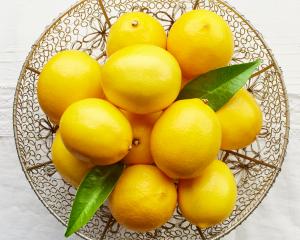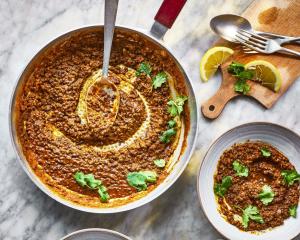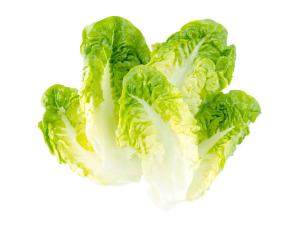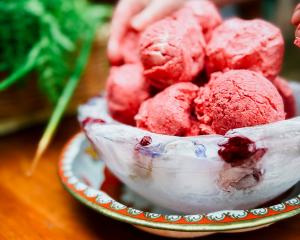
To give out the restaurant's secrets to the public or not?
It is a question that challenged those behind Botswana Butchery as they contemplated producing a cookbook based on the dishes served at its restaurants in Queenstown and Auckland.
In the end Al Spary, who started the restaurant brand in Wanaka in 2007, and chief executive Russell Gray, who came on board in 2009, finally decided it was a good idea.
The book features 80 of the restaurants' most popular dishes, adapted to suit the home cook.
''They've been specially designed to cook in the home, which is different from preparing and cooking for 200,'' Gray said.
It also enabled the company to share the story behind the restaurant brand and how it got its name; Spary was keen to have butchery in its name and the restaurant's chef was from Botswana.
The pair had considered the idea of producing a cookbook after frequent requests from tourists wanting to share their experience with people back home.
But it was not until New Holland publishers approached them that it became a reality late last year.
They then had to go through their menus and pick out the signature dishes from across the full range of courses, from starters and soups to mains, desserts and side dishes.
The response from the public had been positive, he said, with home cooks enjoying the challenge of trying to re-create some of Botswana's dishes at home.
He believes the popularity of the brand comes down to people liking its ''quirkiness'' and its ''fun dining, not fine dining'' concept.
''The name resonates, and the meat cleaver logo.''
Part of the atmosphere was the louder music, the ''theatre'' they created across the kitchen path and, basically, the ''good vibe'', he said.
''It's not a place to go for a quiet romantic evening.''
At the end of the day he believes its success is based on consistency: consistency of quality and presentation of food, and consistency of service and the look and feel.
They had managed to keep the brand fresh by spending a lot of time on its menus, constantly refreshing them with seasonal produce and changing menus six times a year, although some dishes would never drop off, such as the merino lamb shoulder, and whitebait.
''It keeps it current.''
Gray, who is also president of the Auckland Hospitality Association, said while it was a real challenge to recruit and retain good staff in hospitality, the group made training and development a priority.
''It's the biggest challenge we face as an industry. We've found having a good brand and good core values ... they'll stick with you.''
It also helped that the brand's shareholders were all passionate about the business and were hands-on.
''Al and I spend a lot of time in the business working with the teams helping develop new menus, spend a lot of time doing tastings and in training and development.''
With the cookbook on the shelves, they were considering taking the concept to Australia and maybe further afield.
''It's an internationally recognised brand and a lot of tourists say you need to open one of these up in ...''
Whatever happened, its Queenstown waterfront restaurant would remain its flagship.
 Photos supplied.
Split prawns with garlic and parsley butter
Photos supplied.
Split prawns with garlic and parsley butter

These prawns look spectacular when served whole and butterflied. Be careful when preparing as you want to leave the head intact. In the summer months, grill these beauties on the barbecue.
Serves 4
Ingredients
12 whole prawns (shrimp), butterflied
1 Tbsp olive oil
lemon wedges
salad of baby cos (romaine) lettuce leaves and upland cress
chardonnay vinaigrette (see below)
Garlic and parsley butter
2 tsp olive oil
2 garlic cloves, peeled and crushed
4 Tbsp Pernod
3 Tbsp picked flat-leaf (Italian) parsley leaves, very finely shredded
100g unsalted butter
¼ tsp flaky salt
Method
For the garlic and parsley butter, place the oil in a heavy-based saucepan over low heat and add the garlic. Cook for about 1 minute until soft but not coloured.
Increase the heat and add the Pernod. Allow to bubble up and reduce by half.
Add the parsley, remove from heat and whisk in the butter. Season with the salt. Set aside while you quickly fry the prawns.
For the prawns, heat a large frying pan over medium-high heat.
Rub the prawns with the oil and place in the hot frying pan. Fry until they begin to turn pink and the flesh is no longer transparent, two to three minutes.
Have serving plates ready and place three prawns on each with the garlic and parsley butter, a lemon wedge and the salad dressed with enough chardonnay vinaigrette to moisten.
Chardonnay vinaigrette
A staple vinaigrette at Botswana Butchery restaurants.
Ingredients
3 Tbsp chardonnay vinegar
3 Tbsp extra virgin olive oil
salt and freshly ground black pepper.
Method
Place all the ingredients in a small screwtop jar and shake well.
 Slow-roasted shoulder of lamb
Slow-roasted shoulder of lamb

Slow-roast the lamb for three hours until it is almost falling apart. Serve the lamb with mint or redcurrant jelly. For presentation purposes you can ask your butcher to leave part of the top bone intact.
Serves 6-8
Ingredients
1.5kg partially boned shoulder of lamb
1 sprig fresh rosemary
2 Tbsp olive oil
1 tsp flaky salt
3 carrots, scrubbed and roughly chopped
3 celery stalks, roughly chopped
1 onion, peeled and roughly chopped
1 garlic bulb, peeled and crushed
1 litre chicken or beef stock, warmed until hot
Method
Preheat oven to 220degC.
Use kitchen string to tie the lamb shoulder to help it keep its shape during roasting. Thread the rosemary under the string.
Place the lamb in a deep-sided roasting dish and rub with the olive oil and salt. Scatter the vegetables around the lamb.
Place the roasting dish in the oven and roast for 35 to 40 minutes until the lamb skin begins to form a golden crust.
Remove the dish from the oven and reduce the temperature to 140degC. Pour the hot stock into the roasting dish, then cover with a baking paper and foil lid, ensuring the edges are well sealed.
Return to the oven and slow roast for three hours until the meat is very soft to the touch and rich in colour.
Remove the dish from the oven and place the lamb on a warmed plate, cover loosely with the foil lid and a clean tea towel and leave in a warm place while you make the sauce.
Strain the meat juices and vegetables into a saucepan, pressing down on the vegetables to extract maximum flavour and help thicken the sauce.
Gently bring to the boil, skimming off the fat as the sauce boils. Reduce the sauce to a syrupy consistency and taste for seasoning, then pour into a warmed jug for serving.
 Milk chocolate parfait, yoghurt sorbet and salted caramel sauce
Milk chocolate parfait, yoghurt sorbet and salted caramel sauce

Someone told us once that even if you make one component of a more complex recipe then the cookbook is well worth having.
It might just be the salted caramel sauce recipe. You can add more salt to suit your taste if wished. You will need to begin this the day before.
Serves 6
Ingredients
YOGHURT SORBET
350ml full-cream milk
150g caster (superfine) sugar
75g liquid glucose
10g sorbet stabiliser
juice of 1 lemon
500g natural unsweetened yoghurt
MILK CHOCOLATE PARFAIT
5 egg yolks
115g caster (superfine) sugar
3 Tbsp water, plus an extra 3 Tbsp cold water
1 tsp powdered gelatine
100g milk chocolate, melted
25g dark chocolate, melted
250ml single cream, whipped
SALTED CARAMEL SAUCE
200g white sugar
125ml water
100g butter, chopped
125ml single cream or double cream
½ tsp flaky sea salt
TO SERVE
toasted peanuts, chopped
roasted cacao nibs
dark chocolate for grating
Method
To make yoghurt sorbet
Place the milk, sugar, glucose and sorbet stabiliser in a saucepan and bring to the boil. Strain and set aside to cool to room temperature.
Add the lemon juice and yoghurt, mix well then pour into a freezer container, cover and place in the freezer overnight.
To make milk chocolate parfait
Place the egg yolks in an electric mixer and beat until the yolks have doubled in volume.
Meanwhile, place the sugar and three tablespoons of water in a small heavy-based saucepan over a low heat and simmer until the sugar dissolves. Increase the heat and bring to 150degC.
Slowly pour over the egg yolks and continue beating until the egg yolks are light and fluffy and hold their shape.
Place the extra cold water in a ramekin and evenly sprinkle over the gelatine. Let stand for five minutes until the water is absorbed. Place the ramekin in a saucepan with a small amount of water in the base, and heat gently to dissolve the gelatine.
Pour the egg yolk mixture into the melted chocolates and stir in the dissolved gelatine. Fold in the whipped cream.
Spoon the chocolate mixture into serving glasses, parfait glasses or small bowls, cover and place in the fridge until set. You can prepare these the day before.
To make salted caramel sauce
Place the sugar in a wide, heavy-based saucepan and add the water. Carefully dissolve the sugar over a medium heat.
Once the sugar has dissolved, increase the heat to allow the sugar to turn to caramel.
You are looking for a dark caramel. Remove from the heat and being careful, whisk in the butter. Stir in the cream and flaky salt.
Keep any extra salted caramel sauce in a container in the fridge.
To serve
Top each parfait with salted caramel sauce and a scoop of the yoghurt sorbet. Sprinkle over peanuts and cacao nibs and grate over a little chocolate.
The book
Recipes extracted from Botswana Butchery: The Cookbook by Al Spary and Russell Gray, published by New Holland, $50. Available from bookstores or online at www.newhollandpublishers.com.













